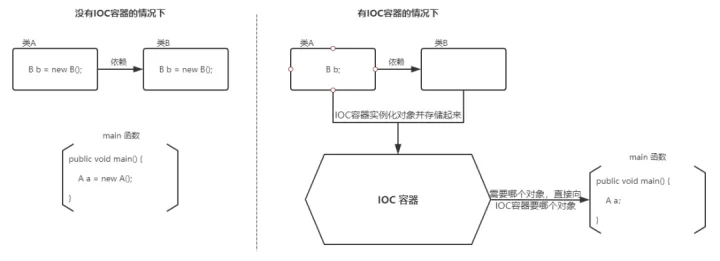-
详解Spring面试IoC和AOP
Spring IOC
一、前言
Spring核心容器的主要组件是Bean工厂(BeanFactory),Bean工厂使用控制反转(IoC)模式来降低程序代码之间的耦合度,并提供了面向切面编程(AOP)的实现。
简单来说,Spring是一个轻量级的控制反转(IoC)和面向切面编程(AOP)的容器框架。
在具体介绍IoC和AOP之前,我们先简要说明下Spring常用注解
1、
@Controller:用于标注控制器层组件2、
@Service:用于标注业务层组件3、
@Component: 用于标注这是一个受 Spring 管理的组件,组件引用名称是类名,第一个字母小写。可以使用@Component(“beanID”) 指定组件的名称4、
@Repository:用于标注数据访问组件,即DAO组件5、
@Bean:方法级别的注解,主要用在@Configuration和@Component注解的类里,@Bean注解的方法会产生一个Bean对象,该对象由Spring管理并放到IoC容器中。引用名称是方法名,也可以用@Bean(name = “beanID”)指定组件名6、
@Scope("prototype"):将组件的范围设置为原型的(即多例)。保证每一个请求有一个单独的action来处理,避免action的线程问题。由于Spring默认是单例的,只会创建一个action对象,每次访问都是同一个对象,容易产生并发问题,数据不安全。
7、
@Autowired:默认按类型进行自动装配。在容器查找匹配的Bean,当有且仅有一个匹配的Bean时,Spring将其注入@Autowired标注的变量中。8、
@Resource:默认按名称进行自动装配,当找不到与名称匹配的Bean时会按类型装配。- 简单点说,就是,能够明确该类是一个控制器类组件的,就用@Controller;
- 能够明确是一个服务类组件的,就用@Service;
- 能够明确该类是一个数据访问组件的,就用@Repository;
- 不知道他是啥或者不好区分他是啥,但是就是想让他动态装配的就用@Component。
@Controller、@Service、@Component、@Repository都是类级别的注解,如果一个方法也想动态装配,就用@Bean。
当我们想按类型进行自动装配时,就用@Autowired;当我们想按名称(beanID)进行自动装配时,就用@Resource;当我们需要根据比如配置信息等来动态装配不同的组件时,可以用getBean(“beanID”)。
二、 IoC和DI
什么是 IoC和DI?
IOC(Inversion of Control)控制反转
例如:现有类 A 依赖于类 B
- 传统的开发方式 :往往是在类 A 中手动通过 new 关键字来 new 一个 B 的对象出来
- 使用 IoC 思想的开发方式 :不通过 new 关键字来创建对象,而是通过 IoC 容器(Spring 框架) 来帮助我们实例化对象。我们需要哪个对象,直接从 IoC 容器里面过去即可。
(1) 什么是控制反转呢?
- 使用对象时,由主动new产生对象转换为由外部提供对象,此过程中对象创建控制权由程序转移到外部,此思想称为控制反转。
- 业务层要用数据层的类对象,以前是自己
new的 - 现在自己不new了,交给
别人[外部]来创建对象 别人[外部]就反转控制了数据层对象的创建权- 这种思想就是控制反转
- 别人[外部]指定是什么呢?继续往下学
- 业务层要用数据层的类对象,以前是自己
(2) Spring和IOC之间的关系是什么呢?
- Spring技术对IOC思想进行了实现
- Spring提供了一个容器,称为IOC容器,用来充当IOC思想中的"外部"
- IOC思想中的
别人[外部]指的就是Spring的IOC容器
(3) IOC容器的作用以及内部存放的是什么?
- IOC容器负责对象的创建、初始化等一系列工作,其中包含了数据层和业务层的类对象
- 被创建或被管理的对象在IOC容器中统称为Bean
- IOC容器中放的就是一个个的Bean对象
(4) 当IOC容器中创建好service和dao对象后,程序能正确执行么?
- 不行,因为service运行需要依赖dao对象
- IOC容器中虽然有service和dao对象
- 但是service对象和dao对象没有任何关系
- 需要把dao对象交给service,也就是说要绑定service和dao对象之间的关系
像这种在容器中建立对象与对象之间的绑定关系就要用到DI:
DI(Dependency Injection)依赖注入
![[外链图片转存失败,源站可能有防盗链机制,建议将图片保存下来直接上传(img-RyTHbZ8n-1672399074574)(E:\工作面试题\Java面试\自己学习笔记\image\1629735078619.png)]](https://1000bd.com/contentImg/2024/04/19/1895549a0a4cf133.png)
(1) 什么是依赖注入呢?
- 在容器中建立bean与bean之间的依赖关系的整个过程,称为依赖注入
- 业务层要用数据层的类对象,以前是自己
new的 - 现在自己不new了,靠
别人[外部其实指的就是IOC容器]来给注入进来 - 这种思想就是依赖注入
- 业务层要用数据层的类对象,以前是自己
(2) IOC容器中哪些bean之间要建立依赖关系呢?
- 这个需要程序员根据业务需求提前建立好关系,如业务层需要依赖数据层,service就要和dao建立依赖关系
为什么叫控制反转
控制 :指的是对象创建(实例化、管理)的权力
反转 :控制权交给外部环境(Spring 框架、IoC 容器)

使用IoC:对象不用卡法这创建,而是交给Spring框架完成(基于XML和基于注解)
基于XML:
开发者把需要创建的对象在XML中进行配置,Spring框架读取这个配置文件,根据配置文件的内容来创建对象
<beans xmlns="http://www.springframework.org/schema/beans" xmlns:xsi="http://www.w3.org/2001/XMLSchema-instance" xmlns:context="http://www.springframework.org/schema/context" xmlns:aop="http://www.springframework.org/schema/aop" xmlns:p="http://www.springframework.org/schema/p" xsi:schemaLocation="http://www.springframework.org/schema/beans http://www.springframework.org/schema/beans/spring-beans.xsd http://www.springframework.org/schema/context http://www.springframework.org/schema/context/spring-context.xsd http://www.springframework.org/schema/aop http://www.springframework.org/schema/aop/spring-aop-4.3.xsd"> <bean class="com.southwind.ioc.DataConfig" id="config"> <property name="driverName" value="Driver">property> <property name="url" value="localhost:8080">property> <property name="username" value="root"> property> <property name="password" value="root"> property> bean> beans>- 1
- 2
- 3
- 4
- 5
- 6
- 7
- 8
- 9
- 10
- 11
- 12
- 13
- 14
- 15
- 16
- 17
- 18
- 19
- 20
- 21
import org.springframework.context.ApplicationContext; import org.springframework.context.support.ClassPathXmlApplicationContext; public class Test { public static void main(String[] args) { // DataConfig dataConfig = new DataConfig(); // dataConfig.setDriverName("Driver"); //dataConfig.setUrl("localhost:3306/dbname"); // dataConfig.setUsername("root"); // dataConfig.setPassword("root"); ApplicationContext context = new ClassPathXmlApplicationContext("spring.xml"); System.out.println(context.getBean("config")); } }- 1
- 2
- 3
- 4
- 5
- 6
- 7
- 8
- 9
- 10
- 11
- 12
- 13
基于注解:
- 配置类(
@Configuration)
用一个 Java 类来替代 XML 文件,把在 XML 中配置的内容放到配置类中。
import com.southwind.ioc.DataConfig; import org.springframework.context.annotation.Bean; import org.springframework.context.annotation.Configuration; @Configuration public class BeanConfiguration { @Bean(value = "config") public DataConfig dataConfig(){ DataConfig dataConfig = new DataConfig(); dataConfig.setDriverName("Driver"); dataConfig.setUrl("localhost:3306/dbname"); dataConfig.setUsername("root"); dataConfig.setPassword("root"); return dataConfig; } }- 1
- 2
- 3
- 4
- 5
- 6
- 7
- 8
- 9
- 10
- 11
- 12
- 13
- 14
- 15
ApplicationContext context = new AnnotationConfigApplicationContext(BeanConfiguration.class); System.out.println(context.getBean("config"));- 1
- 2
- 扫包+配置
更简单的方式,不再需要依赖于 XML 或者配置类,而是直接将 bean 的创建交给目标类,在目标类添加注解来创建。
import lombok.Data; import org.springframework.beans.factory.annotation.Value; import org.springframework.stereotype.Component; @Data @Component public class DataConfig { @Value("localhost:3306") private String url; @Value("Driver") private String driverName; @Value("root") private String username; @Value("root") private String password; }- 1
- 2
- 3
- 4
- 5
- 6
- 7
- 8
- 9
- 10
- 11
- 12
- 13
- 14
- 15
ApplicationContext context = new AnnotationConfigApplicationContext("com.southwi nd.ioc"); System.out.println(context.getBean(DataConfig.class));- 1
- 2
- 3
自动创建对象,完成依赖注入
import lombok.Data; import org.springframework.beans.factory.annotation.Autowired; import org.springframework.beans.factory.annotation.Value; import org.springframework.stereotype.Component; @Data @Component public class GlobalConfig { @Value("8080") private String port; @Value("/") private String path; @Autowired private DataConfig dataConfig; }- 1
- 2
- 3
- 4
- 5
- 6
- 7
- 8
- 9
- 10
- 11
- 12
- 13
- 14
@Autowired 通过类型进行注入,如果需要通过名称取值,通过 @Qualifier 注解完成名称的映射
import lombok.Data; import org.springframework.beans.factory.annotation.Autowired; import org.springframework.beans.factory.annotation.Qualifier; import org.springframework.beans.factory.annotation.Value; import org.springframework.stereotype.Component; @Data @Component public class GlobalConfig { @Value("8080") private String port; @Value("/") private String path; @Autowired @Qualifier("config") private DataConfig dataConfig; }- 1
- 2
- 3
- 4
- 5
- 6
- 7
- 8
- 9
- 10
- 11
- 12
- 13
- 14
- 15
- 16
IoC 解决了什么问题?
IoC 的思想就是两方之间不互相依赖,由第三方容器来管理相关资源。这样有什么好处呢?
- 对象之间的耦合度或者说依赖程度降低;
- 资源变的容易管理;比如你用 Spring 容器提供的话很容易就可以实现一个单例。
参考资料:
- 本文中加入的知乎链接
- B站楠哥学Java – 《两小时弄清楚Spring IOC 和 AOP》
-
相关阅读:
蚂蚁核心架构师内部Java并发编程进阶笔记,白嫖简直太香了!
Web前端:与Angular和React相比,为什么要选择Vue JS
数据结构-堆基本应用刷题
前端_Vue_1.初识Vue
FPGA基础:Verilog HDL
[附源码]计算机毕业设计springboot教务管理系统
自学C#,要懂得善用MSDN
Libco Hook 机制浅析
ERP系统有什么用,主要是这三方面!
Flink Yarn Per Job - 创建启动Dispatcher RM JobManager
- 原文地址:https://blog.csdn.net/weixin_44105632/article/details/128008559
